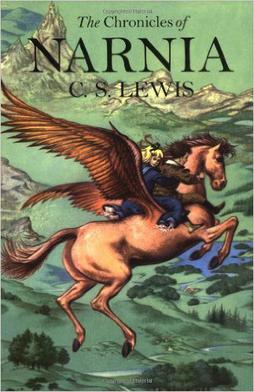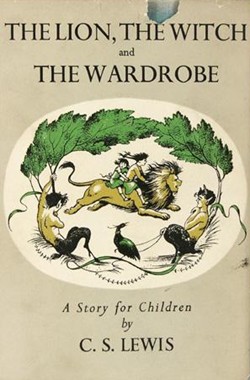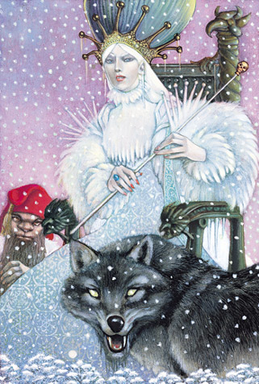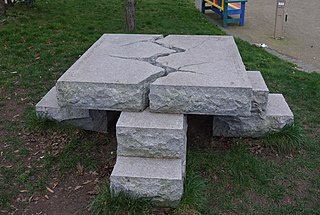
The Chronicles of Narnia is a series of seven portal fantasy novels by British author C. S. Lewis. Illustrated by Pauline Baynes and originally published between 1950 and 1956, The Chronicles of Narnia has been adapted for radio, television, the stage, film, and video games. The series is set in the fictional realm of Narnia, a fantasy world of magic, mythical beasts and talking animals. It narrates the adventures of various children who play central roles in the unfolding history of the Narnian world. Except in The Horse and His Boy, the protagonists are all children from the real world who are magically transported to Narnia, where they are sometimes called upon by the lion Aslan to protect Narnia from evil. The books span the entire history of Narnia, from its creation in The Magician's Nephew to its eventual destruction in The Last Battle.

Prince Caspian is a high fantasy novel for children by C. S. Lewis, published by Geoffrey Bles in 1951. It was the second published of seven novels in The Chronicles of Narnia (1950–1956), and Lewis had finished writing it in 1949, before the first book was out. It is volume four in recent editions of the series, sequenced according to the internal chronology of the books. Like the others, it was illustrated by Pauline Baynes and her work has been retained in many later editions.

The Lion, the Witch and the Wardrobe is a portal fantasy novel for children by C. S. Lewis, published by Geoffrey Bles in 1950. It is the first published and best known of seven novels in The Chronicles of Narnia (1950–1956). Among all the author's books, it is also the most widely held in libraries. It was the first of The Chronicles of Narnia to be written and published, but is marked as volume two in recent editions that are sequenced according the stories' internal chronology. Like the other Chronicles, it was illustrated by Pauline Baynes, and her work has been retained in many later editions.

The Voyage of the Dawn Treader is a portal fantasy novel for children written by C. S. Lewis, published by Geoffrey Bles in 1952. It was the third published of seven novels in The Chronicles of Narnia (1950–1956). Macmillan US published an American edition within the calendar year, with substantial revisions which were retained in the United States until 1994. It is volume five in recent editions, which are sequenced according to the novels' internal chronology. Like the other Chronicles of Narnia, The Voyage of the Dawn Treader was illustrated by Pauline Baynes, and her work has been retained in many later editions.

Mr. Tumnus is a faun in the The Chronicles of Narnia books written by C. S. Lewis, primarily in The Lion, the Witch and the Wardrobe but also briefly in The Horse and His Boy and in The Last Battle. He is the first creature Lucy Pevensie meets in Narnia and becomes her first friend in the kingdom. Lewis wrote that the first Narnia story, The Lion, the Witch and the Wardrobe, all came to him from a single picture he had in his head of a faun carrying an umbrella and parcels through a snowy wood. Tumnus thus became the initial inspiration for the entire Narnia series.

Jadis is a fictional character and the main antagonist of The Lion, the Witch and the Wardrobe (1950) and The Magician's Nephew (1955) in C. S. Lewis's series, The Chronicles of Narnia. She is commonly referred to as the White Witch in The Lion, the Witch and the Wardrobe, as she is the Witch who froze Narnia in the Hundred Years Winter.

Peter Pevensie is a fictional character in C. S. Lewis's The Chronicles of Narnia book series. Peter appears in three of the seven books; as a child and a principal character in The Lion, the Witch and the Wardrobe and Prince Caspian, and as an adult in The Last Battle. He is mentioned in The Horse and His Boy, in which he is away on the northern frontier fighting giants, and in The Voyage of the Dawn Treader, in which he is studying under the tutelage of Professor Kirke.

Susan Pevensie is a fictional character in C. S. Lewis's The Chronicles of Narnia series. Susan is the elder sister and the second eldest Pevensie child. She appears in three of the seven books—as a child in The Lion, the Witch and the Wardrobe and Prince Caspian, and as an adult in The Horse and His Boy. She is also mentioned in The Voyage of the Dawn Treader and The Last Battle. During her reign at the Narnian capital of Cair Paravel, she is known as Queen Susan the Gentle or Queen Susan of the Horn. She was the only Pevensie that survived the train crash on Earth which sent the others to Narnia after The Last Battle.

Edmund Pevensie is a fictional character in C. S. Lewis's The Chronicles of Narnia series. He is a principal character in three of the seven books, and a lesser character in two others.

The Chronicles of Narnia: The Lion, the Witch and the Wardrobe is a 2005 high fantasy film directed by Andrew Adamson, who co-wrote the screenplay with Ann Peacock and the writing team of Christopher Markus and Stephen McFeely, based on the 1950 novel The Lion, the Witch and the Wardrobe, the first published and second chronological novel in the children's book series The Chronicles of Narnia by C. S. Lewis. The film is the first installment in The Chronicles of Narnia film series. It was produced by Walt Disney Pictures and Walden Media, and distributed by Buena Vista Pictures Distribution.

In C. S. Lewis's fantasy novel series the Chronicles of Narnia, the hill of the Stone Table, or Aslan's How, is a high mound or cairn, located south of the Great River in Narnia next to the Great Woods. The How was built over the hill of the Stone Table. The word how derives from the Old Norse haugr, meaning hill or mound. In parts of England, it is a synonym for barrow.

The Chronicles of Narnia is a British BBC-produced television series that was aired from 13 November 1988 to 23 December 1990 and is based on four books of C. S. Lewis's The Chronicles of Narnia series. The first series aired was The Lion, the Witch and the Wardrobe in 1988, the second series aired was Prince Caspian and The Voyage of the Dawn Treader in 1989 and the third series aired was The Silver Chair in 1990. This television series was produced by Paul Stone, with the teleplay by Alan Seymour. The Lion, the Witch, and the Wardrobe was directed by Marilyn Fox, while Prince Caspian, The Voyage of the Dawn Treader and The Silver Chair were directed by Alex Kirby.
The Chronicles of Narnia is a fantasy film series and media franchise based on The Chronicles of Narnia, a series of novels by C. S. Lewis. The series revolves around the adventures of children in the world of Narnia, guided by Aslan, a wise and powerful lion that can speak and is the true king of Narnia. The children heavily featured in the films are the Pevensie siblings, and a prominent antagonist is the White Witch. The franchise also includes short films, digital series, and video games.

Aslan is a major character in C. S. Lewis's The Chronicles of Narnia series. Unlike any other character in the Narnian series, Aslan appears in all seven chronicles. Aslan is depicted as a talking lion and is described as the King of Beasts, the son of the Emperor-Over-the-Sea, and the King above all High Kings in Narnia.
The Lion, the Witch and the Wardrobe is a British children's television drama first broadcast by the BBC in 1988. It was the first series of The Chronicles of Narnia that ran from 1988 to 1990.

The Lion, the Witch and the Wardrobe is an animated television program that was broadcast in two parts on CBS on April 1 and 2, 1979, based on the 1950 novel The Lion, the Witch and the Wardrobe by C. S. Lewis.

Maugrim is a fictional character in the 1950 novel The Lion, the Witch and the Wardrobe by C. S. Lewis. A Narnian wolf, he is the Captain of the White Witch's Secret Police. In early American editions of the book, Lewis changed the name to Fenris Ulf, but when HarperCollins took over the books they took out Lewis' revisions, and the name Maugrim has been used in all editions since 1994.
The following outline is provided as an overview of and topical guide to Narnia:
Magical creatures are an important aspect of the fictional world of Narnia contained within The Chronicles of Narnia book series and connected media originally created by C. S. Lewis. Throughout the seven books of the series, the protagonists encounter a variety of these creatures as they travel throughout Narnia and the surrounding lands and seas, including Archenland, Calormen, and the Great Eastern Ocean.















